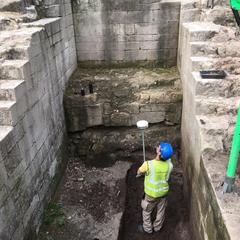Basic Information
- Casing wall in Drawbridge Pit
Contexts
-
Context: PON_1071
Narrative
-
- The earliest remains encountered during the excavation was a heavily degraded limestone wall F120 fronting the natural sandstone edge within the drawbridge pit. It comprised four courses of degraded ashlars to a maximum height of 0.8m mortared in a single 0.3m wide skin to the outer facing edge of the moat. The upper two courses had suffered from significant erosion, particularly towards the centre, and it is most probable this had occurred through weathering of the surface as water drained into the base of the drawbridge pit. Below the wall the natural sandstone upon which it had been constructed was noticeably redder than the surrounding geology and had began to erode, almost undercutting it.
-
- Indie Jago
- 27-4-2021
Dating Narrative
-
- Phase 1 – Casing Wall (12th to 13th century) - dating the casing wall was problematic, but a comparison between it and other remains suggests it had been exposed for significantly longer. Sandstone was quarried locally for building works commissioned at the castle from the 13th century onwards; however, the construction of this wall in limestone indicates it may predate these works, having been erected in the 12th or 13th century.
-
- Indie Jago
- 27-4-2021
Matrix
-
- [not set]
- [not set]
